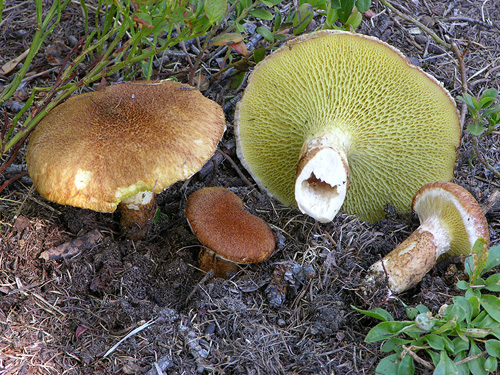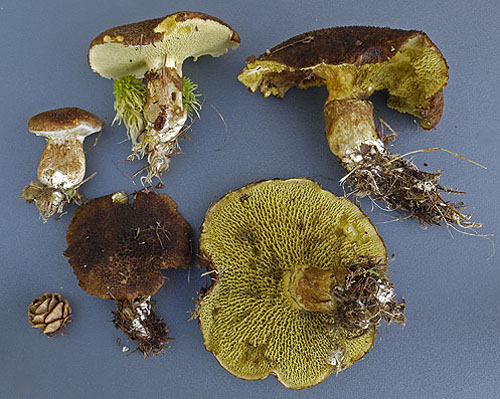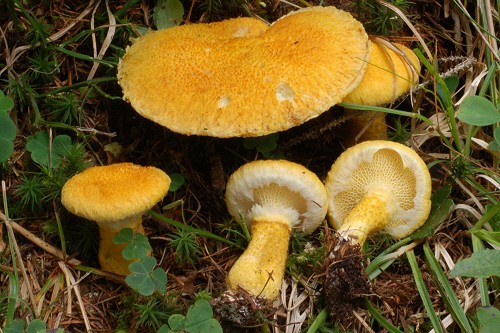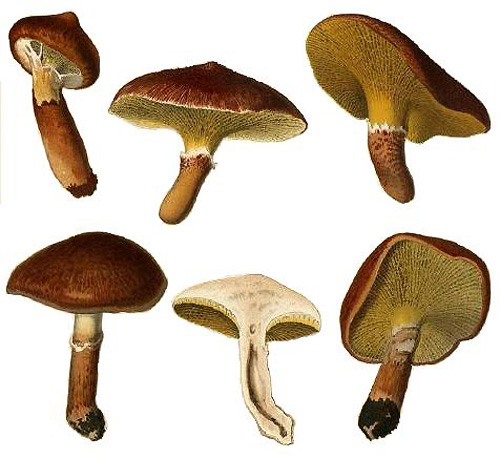Boletinus Kalchbr.
Four species are known in Europe. Fruitbody boletoid with partial veil, leaving a fibrillose ring. Cap fibrillose scaly. Stipe hollow or solid. Tubes decurrent (running down the stipe). There is strong molecular evidence that this genus must be integrated in Suillus; here for practical purposes, I would prefer to list it as a genus on it own. Note also that the genus Fuscoboletinus is also kept separately, although it also must be integrated in Suillus.
Boletinus cavipes (Opat.) Kalchbr.
Description
Cap up to 8 cm, fibrillose scaly, rusty to pale brown (f. cavipes) or yellow (f. aureus (Roll.) Singer). Stipe cylindrical, hollow at least in the lower part, whitish or concolorous with the cap, below the tubes with fibrillose ring. Flesh whitish or yellowish, unchanging when exposed to air. Tubes short, decurrent, pale yellow to olivaceous yellow. Pores large, angular, pale yellow to olivaceous yellow, unchanging when bruised. Smell not distinctive. Taste not distinctive. Spores 7–10.5 × 3.5–4.5 μm.
Habitat. Coniferous forests, mycorrhizal with larch (Larix).
Distribution. In Europe spread within the natural range of large, but also recorded in artificial larch plantations.
Photographs

Fruitbodies of Boletinus cavipes. (photo M. Danz)

Fruitbodies of Boletinus cavipes. Note the hollow stipe seen on the largest fungus and the partial veil on the young fruitbody on the right. (photo M. Danz)

Fruitbodies of Boletinus cavipes. (photo G. Kibby)

Fruitbodies of Boletinus cavipes f. aureus. Apart from the colour the partial veil and the ring are seen very well. (photo M. Floriani)

Fruitbodies of Boletinus cavipes. (photo M. Floriani)

The first known illustration of Boletinus cavipes, published in Kalchbrenner & Schulzer's Icones Selectae Hymenomycetum Hungariae.
Important literature
Alessio, C.L. 1985. Boletus Dill. ex L. (sensu lato). – In: Fungi Europaei. Vol. 2. Pp. 1–705. Libreria editrice Biella Giovanna, Saronno.
Engel, H., Dermek, A., Klofac, W., Ludwig, E. & Brückner, T. 1996. Schmier – und Filzröhrlinge s. l. in Europa. Die Gattungen Boletellus, Boletinus, Phylloporus, Suillus, Xerocomus. Verlag Heinz Engel, Weidhausen b. Coburg.
Estadès, A. & Lannoy, G. 2004. Les bolets européens. – Bulletin Mycologique et Botanique Dauphiné-Savoie 44(3): 3–79.
Galli, R. 1998. I Boleti. Atlante pratico-monographico per la determinazione dei boleti. Edinatura, Milano.
Klofac, W. & Krisai-Greilhuber, I. 1994. Zur Typusdiskussion des Boletinus cavipes. – Österreichische Zeitschrift für Pilzkunde 3: 1–3.
Knudsen, H. & Vesterholt, J. [eds.]. 2008. Funga Nordica. Nordsvamp, Kopenhagen.
Lannoy, G. & Estadès, A. 2001. Les Bolets. Flore mycologique d’Europe. Documents Mycologiques Mémoire Hors série no. 6. Pp. 1–163. Association d’Écologie et de Mycologie, Lille.
Muñoz, J.A. 2005. Boletus s. l. – In: Fungi Europaei. Vol. 1. Pp. 1–951. Edizioni Candusso, Alassio.
Pilát, A. & Dermek, A. 1974. Hríbovité huby. Československé hríbovité a sliziakovité huby (Boletaceae – Gomphidiaceae).Veda, Bratislava.
Šutara, J., Mikšík, M. & Janda, V. 2009. Hřibovité houby. Čeled’ Boletaceae a rody Gyrodon, Gyroporus, Boletinus a Suillus. Academia, Praha.
Watling, R. 1970. Boletaceae, Gomphidiaceae, Paxillaceae. – In: Henderson, D.M., Orton, P.D. & Watling, R. [eds]. British fungus flora. Agarics and Boleti. Vol. 1. Royal Botanic Garden, Edinburgh.
Watling, R. & Hills, A.E. 2005. Boletes and their allies (revised and enlarged edition). – In: Henderson, D.M., Orton,P.D. & Watling, R. [eds]. British Fungus Flora. Agarics and boleti. Vol. 1. Royal Botanic Garden, Edinburgh.